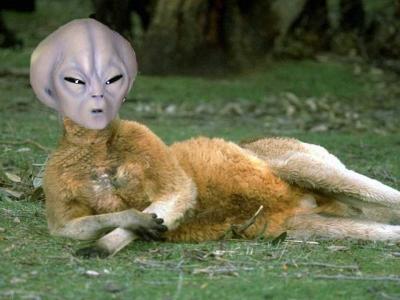
They're aliens ... but not as we know them
Top scientists' ideas of life in space go on display.
By Robin McKie
8-28-05
The Observer UK News
They have been the focus of an interstellar search that has absorbed astronomers for more than 50 years. Despite their best efforts, however, mankind has yet to detect a single piece of convincing evidence that intelligent aliens exist in our galaxy.Top scientists' ideas of life in space go on display.
By Robin McKie
8-28-05
The Observer UK News
Now London's Science Museum has come up with a compromise solution. It is to open an exhibition that will reveal scientists' best predictions about the kinds of extraterrestrials we might one day encounter.
'It is true some scientists believe complex life forms are rare or possibly non-existent,' said Stephen Foulger, manager for the exhibition, the 'Science of Aliens'. 'But the majority still believe they exist. The problem is that they are so distant, we simply cannot detect them. This should not stop us speculating about what kind of worlds they might live on or what they might look like, however. And that is what we have done for the Science Museum exhibition.'
The exhibition aims to show that aliens could be spectacularly unlike anything that has been depicted in science fiction films. These have tended to make monsters and extraterrestrials very human-like, from ET to the monster in Alien. To get around this problem, scientists including the Cambridge palaeontologist, Simon Conway-Morris, picked two very different alien landscapes - one called Aurelia; the other Blue Moon - to provide homes for their life forms. These are the focal points of the exhibition, which will open on 14 October and will coincide with a Channel 4 series, Alien Worlds.
Aurelia is the planet of a red dwarf, a star much cooler than our own Sun. Only planets close to such a star could have sufficient warmth to support life. But the laws of physics dictate that a world in such a tight orbit would be unable to spin. It would be locked in orbit, so one side continually faces its sun, the other into the cold depths of space. Aurelia would have no seasons or days or nights.
The top predator on this world would be the gulphog, scientists speculate. Five metres tall, they have two big powerful legs, long thick necks, small heads and can run at up to 40mph. They hunt mudpods, six-legged creatures that scurry across the planet's surface and live in underground burrows.
Other inhabitants include stinger fans, which resemble plants with fans on top but are really flesh-and-blood animals that use slithery tentacles to move about to capture feeble rays of light that beam down on Aurelia.
Then there is Blue Moon. It orbits a Jupiter-sized planet that in turn orbits a pair of stars in a remote arm of our galaxy. This moon has a thick atmosphere of oxygen and carbon dioxide. So dense is the air here that animals of immense size are capable of flight.
These include skywhales, which float through the soupy atmosphere on 10-metre wings, soaring on the moon's powerful thermal currents. Their only predators are caped stalkers, eagle-like carnivores which can cut into skywhales' flesh, while huge trees that grow three kilometres high provide eco-systems to a fantastic array of other creatures.
These strange worlds and creatures will be displayed on giant screens in the museum and visitors can control actions of the 'gulphogs' and 'skywhales' on display.
Scientists stress that, although such creatures may seems strange, they are only obeying the laws of natural selection that gave rise to life on our planet. As Conway-Morris pointed out: 'Evidence from evolution strongly suggests that, although extraterrestrial regions supporting life will look alien, deep down they will be quite similar to those on Earth.'
Other scientists still believe such worlds are unlikely and that we may be alone in the universe. The development of complex life may simply be too rare to lead to such weird alien menageries. After all the Search for Extraterrestrial Intelligence (Seti) programme has so far found nothing.
Alternatively, intelligent life may be commonplace but not long-lived, as the late evolutionist Stephen Jay Gould pointed out. 'Perhaps any society that could build a technology for such interplanetary travel must first pass through a period of potential destruction where technological capacity outstrips social or moral restraint. Perhaps, no, or very few, societies can ever emerge intact from such a crucial episode.'
Foulger remains optimistic, however. 'I think complex life is going to be fairly commonplace, though it may take us a while to find it.'
More . . .
Home
No comments :
Post a Comment
Dear Reader/Contributor,
Your input is greatly appreciated, and coveted; however, blatant mis-use of this site's bandwidth will not be tolerated (e.g., SPAM, non-related links, etc).
Additionally, healthy debate is invited; however, ad hominem and or vitriolic attacks will not be published, nor will "anonymous" criticisms. Please keep your arguments/comments to the issues and subject matter of this article and present them with civility and proper decorum. -FW